This is the story of Pierre Auberon, “a local boy who done well”. A version of this was published in The Connexion: Dordogne couple uncover history of French home 20 years after purchase
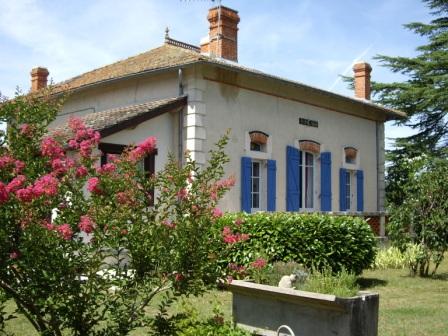
“Les Pommiers”
Pierre AUBERON had this stylish house, which we think can be classified as a “Maison de Maître”, built in the village in 1901. It was probably built as a second home where he and his first wife could escape the pressures of Paris. It is now owned by a delightful young English couple, Derek & Eileen FRENCH, please wave if you pass by.
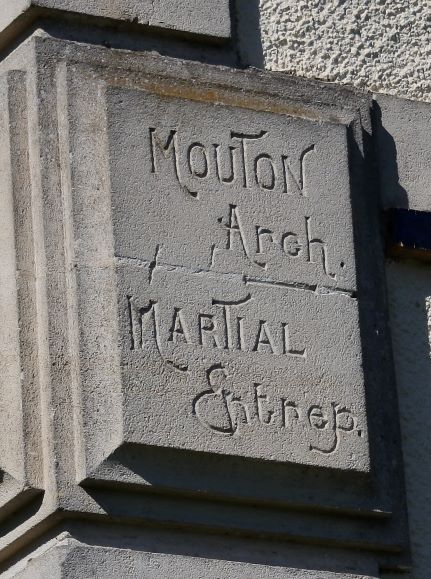
On the front wall of the house is a panel which gives the names of the builder and the architect. This in itself is unusual for the area but it does imitate the style in Paris at the time. Many buildings there, in and around where Pierre AUBERON lived have similar panels. In the words of John Ruskin:
“In no art is there closer connection between our delight in the work, and our admiration of the workman’s mind, than in architecture, and yet we rarely ask for a builder’s name.”
From The Stones of Venice, Chapter II (p. 38), Smith, Elder & Co. 1873
Further research has indicated that the architect was probably Armand Pierre Nicaise MOUTON and the builder Jean MARTIAL.
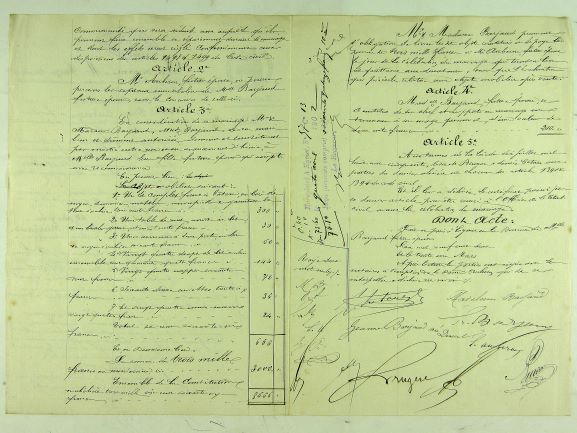
His life
He was born 12th January 1866 to Léonard AUBERON and Marguerite REYGEAUD. The latter lived in the lieu-dit of Le Cardou in Montguyard. His father was a cooper born in 1830 at Queysaguet which lies between Serres and Lauzun.
His first marriage 29th April 1902 was to Hélène BARJEAUD. She was born in 1879 in Eymet, to Louis BARJEAUD, a vet, and Lucette Jeanne DENUEL. He was resident in Paris at the time of the marriage but the ceremony itself took place in Eymet. When they married, she declared a list of furniture and linens that were brought into the marriage for a total value of 666 francs and received 3000 Francs as a dowry. He didn’t declare anything, so we presume that he brought the status of his post on the railways and his being a Lieutenant in the Reserves. Sadly, Hélène died 17th February 1903 shortly after giving birth to a daughter, Lucie. We don’t know whether Lucie survived or not. He married again in 1907. His wife was Augustine MARTINE, who had a daughter, Pauline Ernestine. He adopted Pauline in 1912. She died in Serres in 1978 having lived for a time in Bergerac. We believe that she allowed the house to become a retreat for priests while she was in Bergerac.
It is likely that he was involved with, or at least contributed to the funding of, L’Action française – a right-wing monarchist political party.
He drew his pension in 1929. It was a substantial amount of 20,913 francs and was the result of combining his military service of seven and a half years with his civil servant role of thirty-six and a half years.
He died on the 30th of January 1930 in Paris. The address given on his death certificate was Villa Auguste Blanqui, 29 44 rue Jeanne d’Arc (13th arrondissement).
His career
Our belief is that he joined the military as a private in the 50th infantry in 1887, promoted to corporal in 1888 and sergeant in 1890 when he joined the reserves (subsequently he was promoted to 2nd lieutenant in 1894 when he was transferred from the 148th infantry regiment to the Service des Chemins de fer et des etapes, lieutenant in 1902, capitaine in 1915 and capitaine de reserve honoraire in 1925) . So probably around 1890 he joined the Surveillance Administrative des Chemins de Fer – this was a position which entailed the policing of railway stations and it was probably the practice to employ military personnel.
In his 1914(?) book “La Vie en Chemin de Fer“, Jean-Paul Kurtz poked fun at the position:
“Look at that man with the graying moustache, cut sharply or well-waxed down. He’s clearly an old soldier. He’s decorated with the legion d’honneur. He no longer has black hair decorated with silver braids. Why not? It’s because this man, a former soldier, is the captain of the administrative surveillance at the station. He is the one who represents state interference in the service of companies for whom the state has guaranteed the service of interests. For the ten years I travelled: I saw two hundred administrative surveillance captains. I never saw a single one talk, nor give orders, nor do anything but walk a hundred paces from one side of the station to the other, to kill time. The administrative surveillance captain is the nomad of the station.”
Our first glimpse into his new life, from official sources, comes in 1893 when we find him in Verdun where he was appointed a 4th class commissaire. In 1897 he was appointed to Gare de’Denfert and later the same year he moved to Gare d’Austerlitz. He was an important member of the body representing the Commissaires and in 1900 was appointed Secretary of l’Association amicale des Commissaires de surveillance administrative des Chemins de fer. He is one of the representatives for the “Réseau d’Orleans” and for Paris-Austerlitz in particular.
In 1905 he became President of La Société. With the war he was promoted to capitaine in 1915. From his book we think that he was associated with rebuilding the railway line between Châlons to Batilly after it had been destroyed by the Germans at Aubreville, which was the only means of linking the army at Verdun and the zones of the interior. It is probable that for some time he was based at Pierrefitte-sur-Aire which is about 20 kilometres from Verdun. He would have known the area well as his first post in the Surveillance Administrative des Chemins de Fer was, as mentioned above, in Verdun.
The Author
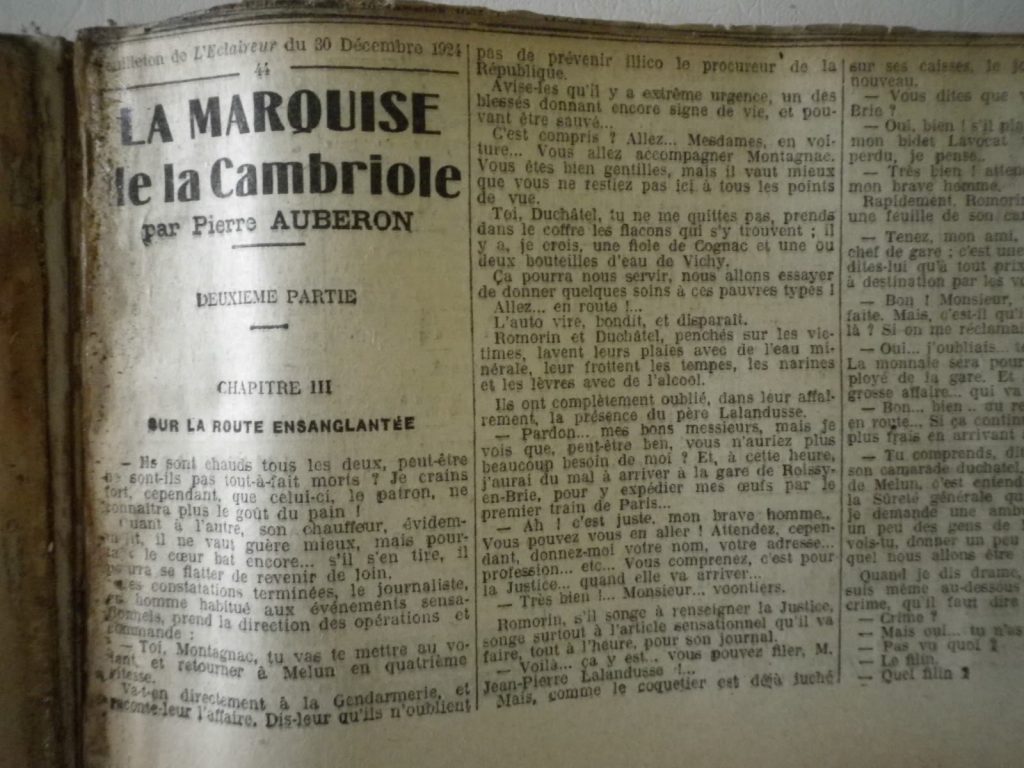
A chance discovery on eBay led us to purchase Pierre AUBERON’s serialized short story, “La Marquise de la Cambriole”. It was publised in 1924 in “L’Eclaireur de Nice”. This was a daily newspaper first published in 1888 and which ceased publication in 1944, it changed its name to “L’Eclaireur de Nice et du Sud-Est” in 1926. Initially we thought it was just coincidence but comparison of the autographs on the document itself and his signature on official documents confirms that he was the author. The item itself comprises cuttings from the original publications.
Currently the “book” is being translated. Once this is done we will provide a synopsis of what appears to quite a racy tale.
The High Life
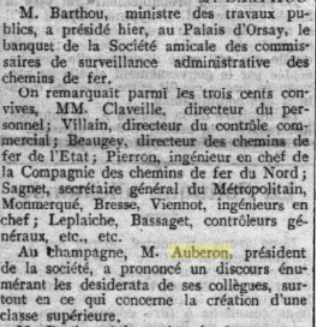
He would have taken part in banquets held by la Société at the Palace d’Orsay. This extract from the 20th March 1908 edition of La Justice has him giving the after dinner speech to an audience including M. BARTHOU the minister for public works. Barthou was prime minister in 1913 and later assassinated with King Alexander I of Yugoslavia during the latter’s state visit to Marseille in October 1934.